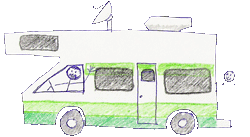Kluane Lake, Yukon/ Haines, Alaska




About 90 miles south of Tok we crossed the border into Yukon Territory once again. This was one of the worst sections of highway that we encountered on our trip (other than the Top of the World Highway). The frost heaves were numerous with washboards that made us slow down to 10-15 mph. There were numerous pot holes and gravel sections with construction still going on. We had been told that one advantage of driving back later in the summer was that most of the construction would be done. The roads really suffer from extreme weather conditions and they can only work on them in the summer months.
We tried to be patient and appreciative of their hard work.
Once again, we are seeing very few facilities available in the Yukon Territory. Many of the restaurants, cabins, etc. closed in the gas crunch of 2006. The drive was beautiful even though it was slow.
We decided to stop on Kluane Lake and stay at the Cottonwood RV Park that was located right on the lake. It was a beautiful and well maintained RV park. They warned us about being careful because grizzlies were in the area. In fact, they had closed the Congdon Creek Yukon campground just 5 miles away because of bear activity.
We have only seen this several times, but the RV park would not accept charge cards. We were happy to have some left over Canadian money from our last stay in Canada. The Yukon Territory has a very small population and is not set up for dealing with tourists. There are a fair amount of RV parks, however, so with careful planning, you can find a place to stay. Again, our main source of information about RV parks is Church’s Traveler’s Guide to Alaskan Camping.
No bears in the campground, but it was a lovely stay on the waters of Kluane Lake. We were up and going early (for a change) and thought that the rough roads were behind us. We were wrong-more of the same.
Finally, better roads, and we arrived in Haines Junction, BC. We filled up with gas at $4.88 a gallon. We couldn’t make it to the cheaper (everything is relative) U.S. gas.
It was a beautiful ride south on the Haines Highway to Haines, Alaska. We passed through alpine meadows that were above the tree line and surrounded by snow covered mountain peaks.
We crossed the U.S. border back into Alaska. We got a few questions about banned items, firearms, money, and then were waved on our way.
It was just an additional 40 miles to our destination of Haines, Alaska. The highway ran beside the Chilkat River and the Alaska Chilkat Bald Eagle Preserve. Most of Alaska’s bald eagles reside in southeast Alaska, with more than 3,000 eagles in this preserve.
We dropped the RV at Haines Hitch-Up RV Park and headed for the ferry dock. It paid off to go down to the ferry dock because we were able to get an earlier ferry. Unfortunately, no space was available back to Bellingham, Washington, but we could get an earlier ferry out to Prince Rupert, BC.
We have enjoyed the peace and quiet and the magnificent scenery of Haines. The small boat harbor sits on the turquoise blue Lynn Canal and is surrounded by majestic jagged peaked mountains that are covered with snow.
This town is not a tourist hot spot because only one cruise ship stops here on Wed. The town only has a half a dozen gift shops and just as many restaurants but we have enjoyed the tranquility and scenery here.
We particularly enjoyed the drive out of town to the Chilkoot Lake State Recreation Site. The salmon were running and so were the fishermen and grizzlies. They coexist along the banks of the river while fishing for salmon. We spent quite a bit of time watching an adolescent grizzly trying to catch a salmon.
Haines is our last Alaska town before we head south on the Alaska Marine Highway ferry.























